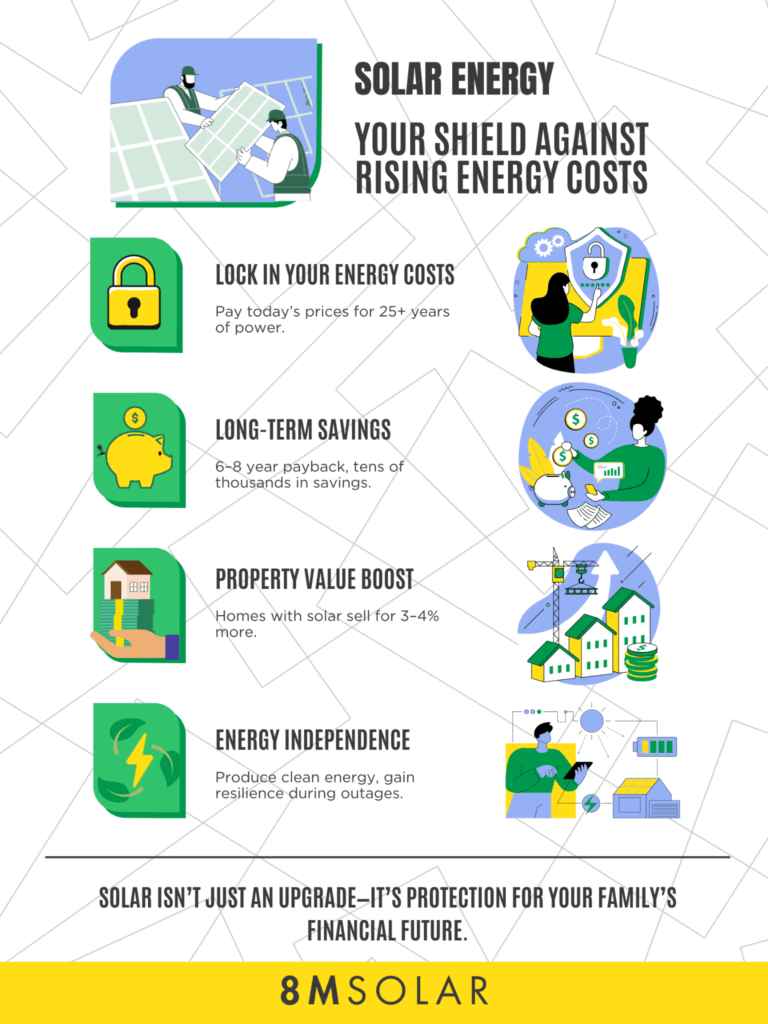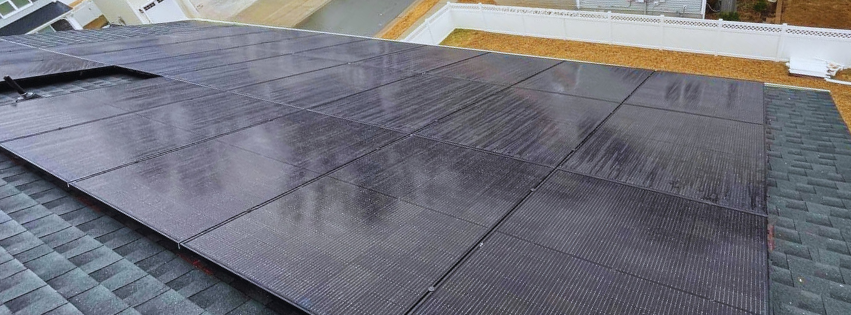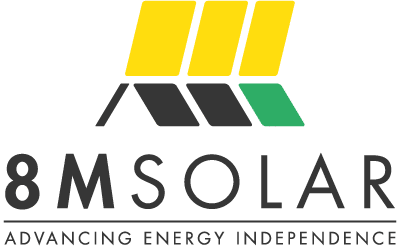If you’ve opened your electricity bill recently and felt your heart skip a beat, you’re not alone. Across North Carolina and the entire United States, homeowners are experiencing sticker shock as their monthly energy costs continue to climb at an alarming rate. What once might have been a manageable $120 monthly bill has now ballooned to $180, $200, or even higher, and there’s no sign of relief on the horizon.
Electricity rates have increased by more than 28% over the past decade, with some regions seeing even steeper jumps. This isn’t just a temporary fluctuation or seasonal adjustment, it’s a shift in how much Americans pay for the power that keeps their homes running. Understanding why these costs are rising is the first step toward protecting your household budget and securing your energy independence.
The Perfect Storm Behind Rising Energy Costs
Several interconnected factors have created the perfect storm driving electricity prices skyward, each compounding the problem and making energy more expensive for families across the country.
Aging Infrastructure Demands Massive Investment
Much of America’s electrical grid was built decades ago, and it’s showing its age. The American Society of Civil Engineers gave the U.S. energy infrastructure a C- grade, highlighting the urgent need for modernization. Utility companies are spending billions to replace aging power lines, transformers, and substations, and they’re passing these infrastructure costs directly to consumers through rate increases.
In North Carolina alone, Duke Energy has invested over $25 billion in grid improvements over the past decade. While these upgrades are necessary for reliability, they translate into higher monthly bills for homeowners who had no say in these infrastructure decisions.
Extreme Weather Events Strain the System
Climate change has intensified weather patterns, creating more frequent and severe storms that damage electrical infrastructure. Hurricane Florence in 2018 caused over $1 billion in electrical system damage across the Carolinas. Each major weather event requires costly repairs and reinforcements, expenses that utilities recover through increased rates.
Beyond storm damage, extreme heat and cold events strain the grid as demand spikes. During the February 2021 Texas freeze, wholesale electricity prices reached $9,000 per megawatt-hour, costs that ripple through the entire energy market and eventually reach consumer bills.
Supply Chain Disruptions Increase Equipment Costs
The global supply chain disruptions that began during the pandemic have impacted the energy sector. Components like transformers, power lines, and generation equipment have seen large price increases. A transformer that cost $3 million in 2019 now costs $5 million or more, with delivery times stretching from months to years.
These supply chain challenges force utilities to pay premium prices for equipment and materials, costs they pass on to ratepayers through higher electricity rates.
Regulatory Changes and Environmental Compliance
New environmental regulations, while important for air quality and climate protection, require investments from power companies. Coal plant retirements, emissions control equipment, and renewable energy mandates all carry costs. The transition away from coal-fired power plants alone has cost utilities billions in stranded assets and replacement generation capacity.
While these changes are necessary for environmental protection, the transition costs are reflected in higher electricity rates during the implementation period.
How Rising Costs Impact Your Household Budget
The effects of rising electricity costs extend past your monthly utility bill. For the average American household spending $125 per month on electricity, a 28% increase means an additional $35 monthly – or $420 annually. Over a decade, this creates thousands of dollars in additional energy expenses.
These increases hit low-income households disproportionately hard, as energy costs become a larger percentage of their total budget. When families spend 6% or more of their income on energy bills, they’re considered energy-burdened, and rising rates push more families into this difficult situation.
Higher electricity costs reduce disposable income available for other necessities like food, healthcare, and education. Many families find themselves choosing between paying their energy bill and covering other essential expenses – a choice no household should have to make.

Solar Power: Your Shield Against Rising Energy Costs
While rising electricity costs seem inevitable, there’s one proven solution that puts you back in control of your energy expenses: solar power. Installing solar panels on your home creates a protective barrier against utility rate increases while providing long-term energy savings that grow more valuable every year.
Lock in Your Energy Costs Today
When you install solar panels, you’re purchasing decades of electricity at today’s prices. While your neighbors see their utility bills increase year after year, your solar system continues producing free electricity from the sun. Over 25 years, this protection against rate increases can save tens of thousands of dollars.
A typical North Carolina household spending $150 monthly on electricity will pay $1,800 annually at current rates. With projected rate increases of 3-4% annually, that same household will pay over $3,600 per year by 2040. Solar panels installed today can eliminate or greatly reduce these costs, providing protection against future rate increases.
Generate Your Own Clean Energy
Solar panels transform your home into a small power plant, generating clean electricity directly from sunlight. This energy independence reduces your reliance on the utility grid and protects you from supply chain disruptions, fuel price volatility, and infrastructure costs that drive utility rate increases.
Modern solar systems are incredibly efficient and reliable, often producing more electricity than your home consumes during peak sunshine hours. Through net metering programs, excess energy flows back to the grid, earning you credits that offset nighttime usage and further reduce your electricity bills.
Increase Your Property Value
Solar installations can increase home values by 3-4%, providing an immediate return on investment. This value increase often equals or exceeds the net cost of the solar system after incentives, making solar essentially a free upgrade that saves money every month.
Real estate studies show that homes with solar panels sell faster and for higher prices than comparable homes without solar. As energy costs continue rising, this value premium is likely to increase as buyers recognize the long-term savings solar provides.
Take Action Now: Why Timing Matters
The current combination of solar incentives, technology efficiency, and rising utility rates creates an optimal window for solar adoption. The federal solar tax credit allows you to deduct 30% of your solar installation costs from your federal taxes, providing savings that won’t last forever.
Federal Solar Tax Credit
The 30% federal solar tax credit creates huge savings on your solar investment. For a $20,000 solar installation, this credit provides $6,000 in tax savings, reducing your system cost to $14,000. This incentive is currently scheduled to go away this year, making now the ideal time to act.
North Carolina Incentives
North Carolina residents can take advantage of additional state-level incentives that further reduce solar costs. Duke Energy’s PowerPair program provides rebates for solar and battery storage systems, creating even greater savings opportunities for homeowners ready to embrace energy independence.
Technology Improvements
Solar panel efficiency has improved dramatically while costs have decreased. Today’s solar panels are more powerful, more durable, and more affordable than ever before. Combined with rising electricity rates, the payback period for solar systems has shortened, reaching just 6-8 years in favorable conditions.

Is Solar Still Worth It Without the Federal Tax Credit?
The answer is yes—and here’s why this matters more than ever.
Under the “One Big Beautiful Bill” signed into law in July 2025, the 30% federal solar tax credit for homeowners expires on December 31, 2025. Any residential solar system must be fully installed and operational by this deadline to qualify for the credit. After January 1, 2026, homeowners purchasing solar systems will lose access to this incentive that has historically saved thousands of dollars on installation costs.
The loss of the federal tax credit might seem like a reason to abandon solar plans, but the mathematics tell a different story. While the upfront savings disappear, the long-term value of solar energy actually becomes more compelling as electricity rates continue their relentless climb.
Without the federal tax credit, a $20,000 solar installation no longer benefits from the $6,000 tax savings that previously reduced the effective cost to $14,000. However, rising electricity rates create savings that increasingly outweigh this loss over time.
A homeowner currently paying $180 monthly for electricity spends $2,160 annually. With electricity rates projected to increase ~5% annually, that same household will pay approximately $2,850 per year by 2035 and over $3,600 by 2040. A solar system installed in 2026 at full price will eliminate or reduce these costs for 25-30 years, creating cumulative savings of $60,000 to $90,000 over the system’s lifetime. Even without the federal tax credit, most homeowners can expect payback periods of 8-12 years for solar installations.
State and Local Incentives Still Available
The federal tax credit isn’t the only financial incentive for solar adoption. North Carolina residents can take advantage of Duke Energy’s PowerPair program, which provides rebates for solar and battery storage systems. These state-level incentives, combined with net metering programs that credit you for excess energy production, continue to improve the economics of solar installation.
Property tax exemptions for solar installations also remain in effect, ensuring that adding solar panels doesn’t increase your property tax burden despite increasing your home’s value.
Solar panel efficiency has improved greatly while costs have decreased. Today’s solar panels are more powerful, more durable, and more affordable than ever before. Combined with rising electricity rates, the payback period for solar systems has shortened significantly, often reaching just 6-8 years in favorable conditions.
Protect Your Family’s Financial Future
Rising electricity costs are a long-term threat to your household budget, but solar power provides a solution that grows more valuable over time. Every month you delay solar installation is another month of rising utility bills and missed savings opportunities.
8MSolar has helped thousands of North Carolina homeowners break free from rising energy costs through custom solar solutions designed for maximum savings and performance. Our expert team handles every aspect of the solar process, from initial consultation through system activation, ensuring you start saving from day one.
With 8MSolar’s 25-year warranty coverage and proven track record of exceptional customer service, you can invest in solar with confidence. Our hardware-agnostic approach means we select the best equipment for your situation, not whatever inventory we need to move.
Ready to Escape Rising Energy Costs?
Don’t let another month of increasing electricity bills drain your budget. Contact 8MSolar today to discover how solar power can protect your family from rising energy costs while providing decades of clean, affordable electricity. Our solar experts will design a custom system that maximizes your savings and delivers the energy independence you deserve.
The sun rises every day, providing free energy that can power your home for decades to come. With 8MSolar’s expertise and commitment to customer satisfaction, you can harness this abundant resource and finally take control of your energy costs. Start your journey toward energy independence today – your future self will thank you for making the smart choice now.

